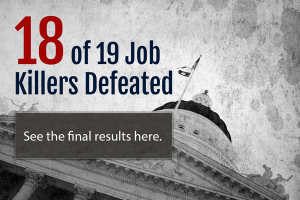 A California Chamber of Commerce opposed job killer bill that would drastically expand a California 12-week protected leave of absence to small employers with only 25 employees, and create the opportunity for employees working for employers with 50 employees to take up to 24 weeks — almost half of year — of protected leave has advanced to the Assembly Floor for a vote in the coming days.
A California Chamber of Commerce opposed job killer bill that would drastically expand a California 12-week protected leave of absence to small employers with only 25 employees, and create the opportunity for employees working for employers with 50 employees to take up to 24 weeks — almost half of year — of protected leave has advanced to the Assembly Floor for a vote in the coming days.
SB 406 (Jackson; D-Santa Barbara) would apply to both large and small employers (those with 25 employees or more) and poses the risk of additional costs and litigation. The bill would force small employers with only 25 employees to provide their employees with 12 weeks of protected leave, which is a significant burden on employers with such a limited workforce. Further, the bill significantly expands the type of individuals for which employees can take the leave of absence to care for, which create lack of conformity with the federal counterpart Family Medical Leave Act (FMLA), and thereby creates an opportunity for an employee to take 12 weeks of protected leave under California law, and another 12 weeks of protected leave under FMLA. Under the proposal, in order to be eligible for the leave, employees would only have had to be employed for one year and worked at least 1,250 hours in the 12 months prior to taking the leave.
SB 406 Will Overwhelm Small Businesses
Currently, CFRA requires an employer with 50 or more employees to allow an employee who has worked at least 1,250 hours to take up to 12 weeks of leave in a 12-month period for the employee’s own serious medical condition, for the birth or placement of a child, or to care for the serious medical condition of a child (under 18 years of age or adult dependent), spouse or parent. The current definition of “parent” includes step-parents, as well as individuals who stand in loco parentis to the child.
SB 406 seeks to impose this 12-week protected leave of absence on employers with only 25 employees within 75 miles of each other. Such a significant expansion of a protected leave of absence will simply overwhelm small businesses that have such a limited workforce.
Specifically, after meeting minimum qualifications, an employee’s leave under CFRA is absolute and must be allowed, regardless of the undue burden it will create on the employer. Employers could have multiple employees already out on a variety of protected leaves or employer-offered leaves of absence, and still must allow any other employee who meets the qualifications of CFRA to have a protected 12- week leave of absence as well. Once the regular employee is out on leave, the employer must hire and train a temporary employee to cover the duties of the employee on leave, pay an existing employee a higher wage or overtime to take on the duties, or suffer decreased productivity until the employee out on leave is ready to return to work. CFRA is a protected leave and, therefore, the employer must return the employee to his or her same position, or else face costly litigation.
Expanding this significant burden to an employer with only 25 employees is unfair. CFRA is difficult for larger employers with an extensive workforce to administer and manage. Small employers in California will not be able to comply with this mandate.
SB 406 Will Expand the Amount of Protected Leave an Employee May Take
In addition to expanding the number of employers who must provide the protected leave of absence, SB 406 expands the family members for whom an employee may take a 12-week protected leave of absence to include a grandparent, a grandchild and siblings. The initial intent of CFRA was to provide a balance between an individual’s work life and personal life. However, this proposed change would certainly disrupt that balance and have a negative impact on California employers.
Given that these proposed individuals under SB 406 are not covered under the corresponding and similar leave provided by the federal Family and Medical Leave Act, this bill will potentially require a California employer to provide up to 24 weeks of protected leave. Specifically, under SB 406, an employee could utilize his or her 12 weeks of CFRA to care for the serious medical condition of a grandparent, who is not a family member covered under FMLA and, therefore, would not trigger FMLA leave. Upon returning, the employee still would be entitled to another 12-week protected leave of absence under FMLA for his or her own medical condition or the medical condition of his or her spouse, child or parent. Notably, an employee can take CFRA and FMLA in increments as small as one hour at a time, thereby providing an extensive amount of protected time off for California-only employees, that California-only employers would have to administer and track properly to protect against potential liability. An employee would have to satisfy the same eligibility requirements under current CFRA/FMLA — worked for the employer at least one year and at least 1,250 hours in the 12 months before they take the leave.
SB 406 Will Expose Small Employers to Costly Litigation
CFRA includes a private right of action with the opportunity to obtain compensatory damages, injunctive relief, declaratory relief, punitive damages, and attorney’s fees. This private right of action creates costly litigation for employers, even when employers take reasonable steps to address abuse under CFRA. For example, in Richey v. Autonation, an employee took CFRA leave from his employer for 12 weeks due to his own medical condition. However, while on “medical leave,” the employee opened and worked at his own restaurant. The employer fired the employee and the employee sued the employer for retaliation for taking CFRA. Although the employer ultimately prevailed, the employer had to pay for litigation for more than six years.
In McDaneld v. Eastern Municipal Water District Board, the court ruled against the employee who sued his employer for violating CFRA after the employee was terminated because he was found golfing and performing intermittent sprinkler installation/repair while he had requested time off to care for his father.
Exposing small employers with limited labor force, resources and finances to such costly litigation when the employee has engaged in abuse is unfair and a significant burden to California’s small businesses.
Majority of States Impose Mandated Family Leave Only on Employers with 50 or More Employees
As set forth in a 2013 study for the National Conference of State Legislatures, 43 other states either follow federal law, which requires 12 weeks of family leave for employers with 50 or more employees, and/or have a similar state law that imposes only a 12-week leave of absence on employers with 50 or more employees.
As set forth in the study, seven states have family medical leave laws that apply to employers with fewer than 50 employees, but the majority of those states do not: (1) have the extensive list of protected leaves of absence that California already has (as set forth below); and/or (2) the amount of time off or covered conditions required by these other states is less.
For example, Minnesota leave applies to employers with 21 or more employees, but is applicable only to leave for the birth or adoption of a child, not a medical condition of an employee or family member. Similarly, Maine’s leave applies to employers with 15 or more employees, but allows only 6 weeks for the birth or adoption of a child, as opposed to 12 weeks.
California Already Has Extensive List of Protected Leave of Absences
California already has extensive family-related protected leaves of absence, including the following: Paid Sick Leave (applicable to all employers and includes employee and family members); Kin Care (applicable to all employers and allows employees to use half of paid time off for family members’ illnesses); California Family Rights Act (applicable to employees with 50 or more employees and provides 12-week leave of absence for employee’s medical condition, family members medical condition, or to bond with new child); Pregnancy Disability Leave (applicable to employers with 5 or more employees and provides 4 months of protected leave that is in addition to CFRA’s 12 weeks); School Activities Leave (applicable to employers with 25 or more employees for 40 hours per year to attend school related activities of a child).
Imposing another, 12-week leave of absence on employers with only 25 employees is simply too much for many of these small employers to manage.
Action Needed
SB 406 is awaiting a vote by the Assembly. Contact your Assembly representative and urge him/her to vote no on SB 406.
Staff Contact: Jennifer Barrera


